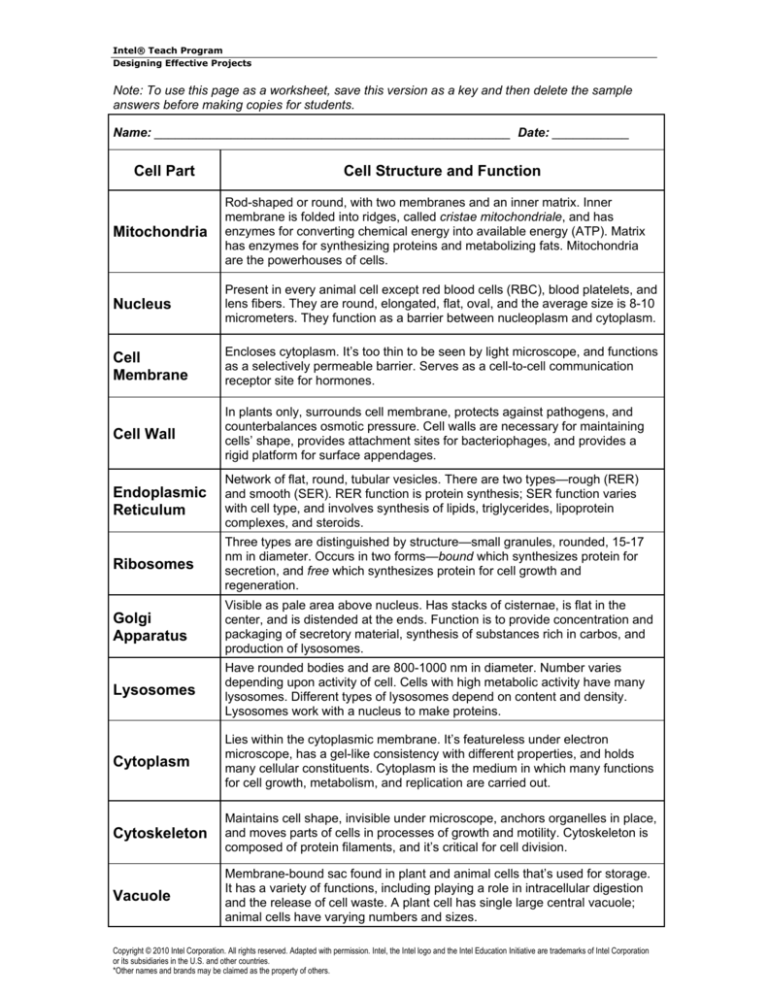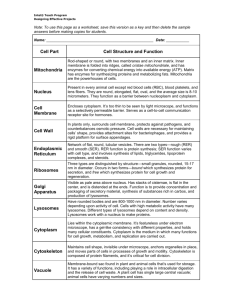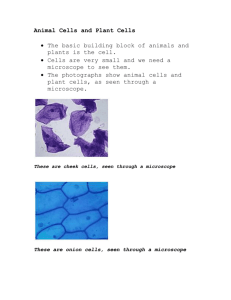
Intel® Teach Program
Designing Effective Projects
Note: To use this page as a worksheet, save this version as a key and then delete the sample
answers before making copies for students.
Name: ___________________________________________________ Date: ___________
Cell Part
Cell Structure and Function
Mitochondria
Rod-shaped or round, with two membranes and an inner matrix. Inner
membrane is folded into ridges, called cristae mitochondriale, and has
enzymes for converting chemical energy into available energy (ATP). Matrix
has enzymes for synthesizing proteins and metabolizing fats. Mitochondria
are the powerhouses of cells.
Nucleus
Present in every animal cell except red blood cells (RBC), blood platelets, and
lens fibers. They are round, elongated, flat, oval, and the average size is 8-10
micrometers. They function as a barrier between nucleoplasm and cytoplasm.
Cell
Membrane
Encloses cytoplasm. It’s too thin to be seen by light microscope, and functions
as a selectively permeable barrier. Serves as a cell-to-cell communication
receptor site for hormones.
Cell Wall
In plants only, surrounds cell membrane, protects against pathogens, and
counterbalances osmotic pressure. Cell walls are necessary for maintaining
cells’ shape, provides attachment sites for bacteriophages, and provides a
rigid platform for surface appendages.
Endoplasmic
Reticulum
Network of flat, round, tubular vesicles. There are two types—rough (RER)
and smooth (SER). RER function is protein synthesis; SER function varies
with cell type, and involves synthesis of lipids, triglycerides, lipoprotein
complexes, and steroids.
Ribosomes
Three types are distinguished by structure—small granules, rounded, 15-17
nm in diameter. Occurs in two forms—bound which synthesizes protein for
secretion, and free which synthesizes protein for cell growth and
regeneration.
Golgi
Apparatus
Visible as pale area above nucleus. Has stacks of cisternae, is flat in the
center, and is distended at the ends. Function is to provide concentration and
packaging of secretory material, synthesis of substances rich in carbos, and
production of lysosomes.
Lysosomes
Have rounded bodies and are 800-1000 nm in diameter. Number varies
depending upon activity of cell. Cells with high metabolic activity have many
lysosomes. Different types of lysosomes depend on content and density.
Lysosomes work with a nucleus to make proteins.
Cytoplasm
Lies within the cytoplasmic membrane. It’s featureless under electron
microscope, has a gel-like consistency with different properties, and holds
many cellular constituents. Cytoplasm is the medium in which many functions
for cell growth, metabolism, and replication are carried out.
Cytoskeleton
Maintains cell shape, invisible under microscope, anchors organelles in place,
and moves parts of cells in processes of growth and motility. Cytoskeleton is
composed of protein filaments, and it’s critical for cell division.
Vacuole
Membrane-bound sac found in plant and animal cells that’s used for storage.
It has a variety of functions, including playing a role in intracellular digestion
and the release of cell waste. A plant cell has single large central vacuole;
animal cells have varying numbers and sizes.
Copyright © 2010 Intel Corporation. All rights reserved. Adapted with permission. Intel, the Intel logo and the Intel Education Initiative are trademarks of Intel Corporation
or its subsidiaries in the U.S. and other countries.
*Other names and brands may be claimed as the property of others.












